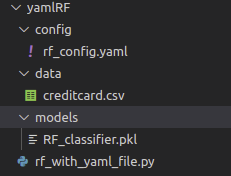编程中免不了要写配置文件,今天我们继续Python网络编程,学习一个比 JSON 更简洁和强大的语言————YAML 。本文老胡简单介绍 YAML 的语法和用法,以及 YAML 在机器学习项目中的应用实例。欢迎大家一起学习,也欢迎点赞、在看、分享!
前篇:
YAMLYAML 是 "YAML Ain't a Markup Language"(YAML 不是一种标记语言)的递归缩写。YAML 的语法和其他高级语言类似,并且可以简单表达清单、散列表,标量等数据形态。它使用空白符号缩进和大量依赖外观的特色,特别适合用来表达或编辑数据结构、各种配置文件、倾印调试内容、文件大纲。YAML 的配置文件后缀为 .yaml
YAML 它的基本语法规则如下:
大小写敏感
使用缩进表示层级关系
缩进时不允许使用Tab键,只允许使用空格。
缩进的空格数目不重要,只要相同层级的元素左侧对齐即可
号 表示注释
YAML 支持的数据结构有三种:
对象:键值对的集合,对象键值对使用冒号结构表示 key: value,冒号后面要加一个空格。
数组:一组按次序排列的值,又称为序列/ 列表,用 - 表示。
纯量(scalars):单个的、不可再分的值
YAML 用法安装
pip install pyyamlyaml 文件格式很简单,比如:
# categories.yaml file sports: #注意,冒号后面要加空格 - soccer # 数组 - football - basketball - cricket - hockey - table tennis countries: - Pakistan - USA - India - China - Germany - France - Spainpython 读取 yaml 文件
# read_categories.py file import yaml with open(r'categories.yaml') as file: documents = yaml.full_load(file) for item, doc in documents.items(): print(item, ":", doc)运行结果:
sports : ['soccer', 'football', 'basketball', 'cricket', 'hockey', 'table tennis'] countries : ['Pakistan', 'USA', 'India', 'China', 'Germany', 'France', 'Spain']以上便是 YAML 最基础的应用了,可能大家还是有点一头雾水,咱们更进一步,看看在机器学习项目中如何写 YAML 配置文件。
YAML & Machine Learning我们直接改写中的代码。

写配置文件rf_config.yaml
#INITIAL SETTINGS data_directory: ./data/ data_name: creditcard.csv target_name: Class test_size: 0.3 model_directory: ./models/ model_name: RF_classifier.pkl #RF parameters n_estimators: 50 max_depth: 6 min_samples_split: 5 oob_score: True random_state: 666 n_jobs: 2完整代码,可以对比源代码看看区别:
# rf_with_yaml_file.py import os import yaml import joblib import numpy as np import pandas as pd from sklearn.model_selection import train_test_split from sklearn.ensemble import RandomForestClassifier from sklearn.metrics import roc_auc_score CONFIG_PATH = "./config/" def load_config(config_name): with open(os.path.join(CONFIG_PATH, config_name)) as file: config = yaml.safe_load(file) return config config = load_config("rf_config.yaml") df = pd.read_csv(os.path.join(config["data_directory"], config["data_name"])) data = df.iloc[:, 1:31] X = data.loc[:, data.columns != config["target_name"]] y = data.loc[:, data.columns == config["target_name"]] number_records_fraud = len(data[data.Class == 1]) fraud_indices = np.array(data[data.Class == 1].index) normal_indices = data[data.Class == 0].index random_normal_indices = np.random.choice( normal_indices, number_records_fraud, replace=False) random_normal_indices = np.array(random_normal_indices) under_sample_indices = np.concatenate( [fraud_indices, random_normal_indices]) under_sample_data = data.iloc[under_sample_indices, :] X_undersample = under_sample_data.loc[:, under_sample_data.columns != config["target_name"]] y_undersample = under_sample_data.loc[:, under_sample_data.columns == config["target_name"]] X_train, X_test, y_train, y_test = train_test_split( X, y, test_size=config["test_size"], random_state=42 ) rf1 = RandomForestClassifier( n_estimators=config["n_estimators"], max_depth=config["max_depth"], min_samples_split=config["min_samples_split"], oob_score=config["oob_score"], random_state=config["random_state"], n_jobs=config["n_jobs"] ) rf1.fit(X_train, y_train) print(rf1.oob_score_) y_predprob1 = rf1.predict_proba(X_test)[:, 1] print("AUC Score (Train): %f" % roc_auc_score(y_test, y_predprob1)) joblib.dump(rf1, os.path.join(config["model_directory"], config["model_name"])) referencehttps://www.runoob.com/w3cnote/yaml-intro.html
https://www.ruanyifeng.com/blog/2016/07/yaml.html

